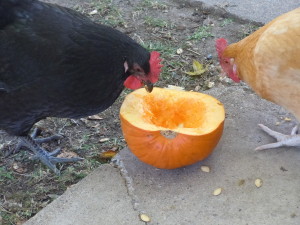
Five more probable cases of avian influenza were announced Monday, April 27, 2015, at Iowa poultry farms. (photo/Cindy Hadish)
A conference call with reporters last week described the massive numbers of chickens that would be euthanized on one farm in northwest Iowa as the single biggest loss seen thus far from avian influenza. Two Iowa turkey farms also have been hit by the virus, commonly known as bird flu.
Now comes word that five more commercial poultry farms also likely have cases of the H5N2 strain of the disease and the numbers are staggering.
As the majority of the birds are not free-range, investigation continues into the routes of transmission, though experts say it’s likely spread from wild birds. The end result is that millions more chickens will be killed in Iowa.
If you’re a backyard chicken owner, keep a close eye on your chickens to make sure they’re not in contact with wild birds.
Here is more from the Iowa Department of Agriculture and Land Stewardship on the latest cases:
DES MOINES – The Iowa Department of Agriculture and Land Stewardship is responding to five probable cases of highly pathogenic avian influenza (HPAI) in commercial poultry farms in Osceola, O’Brien and Sioux Counties in Northwest Iowa. These five new cases would join three confirmed cases of the disease in Iowa. State officials have quarantined the premises and if the initial test are confirmed, all birds on the property will be humanely euthanized to prevent the spread of the disease.
Osceola County 2 – Pullet farm with an estimated 250,000 birds. Initial testing showed it positive for H5 avian influenza. Additional confirmatory testing is pending from the APHIS National Veterinary Services Laboratories (NVSL) in Ames.
O’Brien County 1 – Commercial laying operation with an estimated 240,000 birds that has experienced increased mortality. Initial testing showed it positive for H5 avian influenza. Additional confirmatory testing is pending from the APHIS National Veterinary Services Laboratories (NVSL) in Ames.
O’Brien County 2 – Commercial laying operation with an estimated 98,000 birds that has experienced increased mortality. Initial testing showed it positive for H5 avian influenza. Additional confirmatory testing is pending from the APHIS National Veterinary Services Laboratories (NVSL) in Ames.
Sioux County 1 – Commercial laying operation with an estimated 1.7 million birds that has experienced increased mortality. Initial testing showed it positive for H5 avian influenza. Additional confirmatory testing is pending from the APHIS National Veterinary Services Laboratories (NVSL) in Ames.
Sioux County 2 – Commercial laying operation with an estimated 3.8 million birds that has experienced increased mortality. Initial testing showed it positive for H5 avian influenza. Additional confirmatory testing is pending from the APHIS National Veterinary Services Laboratories (NVSL) in Ames.
The Center for Disease Control (CDC) and Iowa Department of Public Health considers the risk to people from these HPAI H5 infections in wild birds, backyard flocks and commercial poultry, to be low. No human infections with the virus have ever been detected there is no food safety risk for consumers.
The United States has the strongest Avian Influenza (AI) surveillance program in the world. As part of the existing USDA avian influenza response plans, Federal and State partners as well as industry are responding quickly and decisively to these outbreaks by following these five basic steps: 1) Quarantine – restricting movement of poultry and poultry-moving equipment into and out of the control area; 2) Eradicate – humanely euthanizing the affected flock(s); 3) Monitor region – testing wild and domestic birds in a broad area around the quarantine area; 4) Disinfect – kills the virus in the affected flock locations; and 5) Test – confirm that poultry farms in the area are free of the virus.
The Iowa Department of Agriculture and Land Stewardship in partnership with the Iowa Department of Public Health are working directly with poultry workers at the affected facility to ensure proper precautions are being taken.
These virus strains can travel in wild birds without those birds appearing sick. People should avoid contact with sick/dead poultry or wildlife. If contact occurs, wash your hands with soap and water and change clothing before having any contact with healthy domestic poultry and birds.
All bird owners, whether commercial producers or backyard flock owners, should continue to practice good biosecurity, prevent contact between their birds and wild birds, and report sick birds or unusual bird deaths to state/federal officials, either through their state veterinarian at 515-281-5321 or through USDA’s toll-free number at 1-866-536-7593.

No Comments Yet